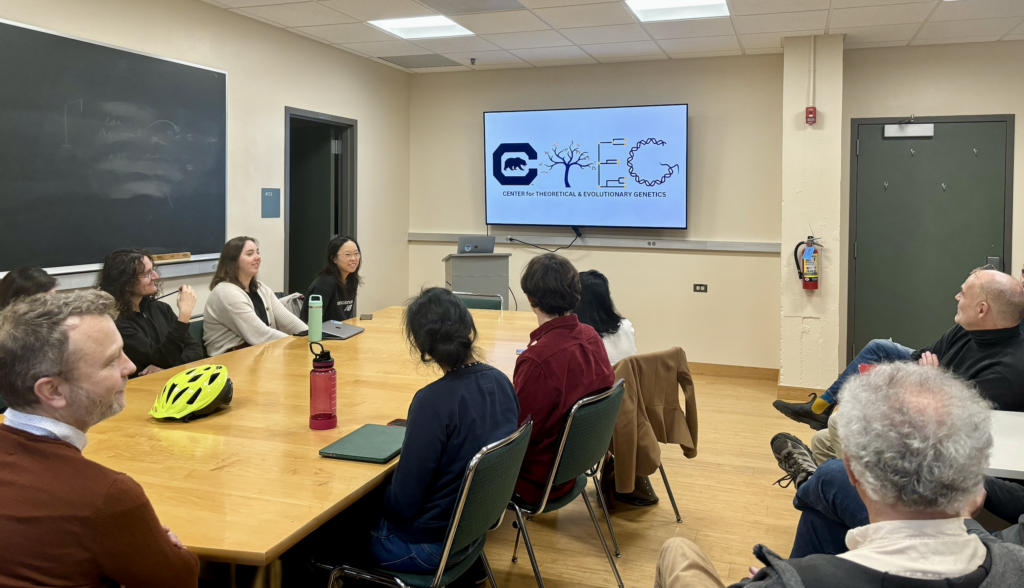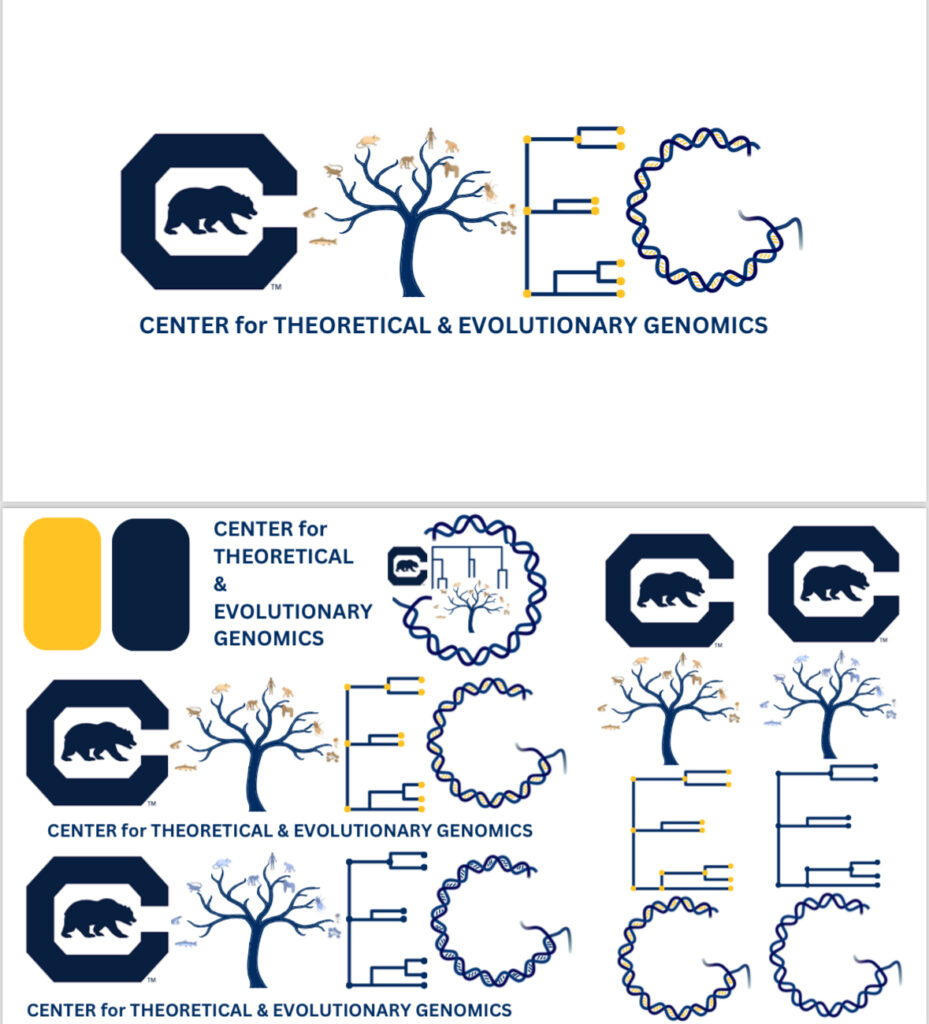How a small group of scientists has grown into a collaborative community
For most graduate students, a 4:00 pm meeting on a Friday is the last place they would choose to be. But if you walk into 4163 VLSB, you’ll see a gathering of graduate students, postdocs, PIs, and other curious scientists listening intently to a works-in-progress presentation by one of their peers.
After the meeting, the gathered scientists shuffle over to the nearby fridge, crack open a beer, and continue their conversation, asking questions about the research methods applied, what their next steps are, or what new things are going on in the lab.
This is CTEG: the weekly meeting of the Center for Theoretical Evolutionary Genomics, where students and faculty alike mingle to share scientific updates in a casual setting.
CTEG was started in 2008 as an “unofficial organization” with the hiring of Integrative Biology (IB) and Computational Biology (CCB) faculty. The founding faculty members included Doris Bachtrog, John Huelsenbeck, Rasmus Nielsen, Montgomery “Monty” Slatkin, and Yun Song, all but Song located on the 4th floor of VLSB on UC Berkeley’s campus.
The group formed as Slatkin, Nielsen, and Hulesenbeck were bouncing around ideas for an unofficial group one day. “I thought ‘Center for Theoretical Evolutionary Genetics’ was a good name. Monty suggested changing the ‘Genetics’ to ‘Genomics’. Thus, CTEG was born,” recounted Huelsenbeck.
He noted that the community was pretty loose knit for at least a decade and has more recently gained momentum with the addition of faculty members Moisés Expósito-Alonso, Priya Moorjani, and Peter Sudmant. This has added a great amount of breadth to the research areas highlighted in CTEG, ranging from population genetics to plant biology. The diverse research happening in CTEG is a strength of the community, a sentiment which Huelsenbeck echoes.

“It’s unusual to find faculty collaborating in such a complementary way,” Huelsenbeck notes. “Usually, labs are organized like separate kingdoms. I like the idea that we have organized a strong affinity group where people from different labs can talk about their research and current research problems, perhaps learning from students or faculty in other labs.”
Creating a collaborative scientific environment is ultimately the goal of CTEG. Having a clear meeting space and time each week offers students and faculty across the campus an opportunity to gather in a low-stakes environment.
Graduate school can be stressful and sharing research updates can be intimidating. There is immense pressure on students to be successful scientists, even when the definition of “success” may be a vague one. It is difficult to practice and develop important skills as a scientist, such as public speaking and presentations, or sharing works in progress with adequate transparency. There are few spaces for students to share research while gaining constructive feedback. Weekly CTEG meetings offer a chance to share the ups and downs of research and bounce ideas off of peers, enabling scientific growth.
In establishing these CTEG meetings, Huelsenbeck emphasized the need to foster the development of young scientists. “There’s a reason we organized in the way we did and that was to throw students into contact with other smart students, postdocs, and faculty where they can learn skills that will help them in their career,” he shared. “We also want the graduate school experience to be a positive one…Graduate school can be a positive experience.”
I currently serve on the CTEG organizing committee, helping to nominate and manage weekly seminar meetings. I see firsthand how CTEG has grown to be a positive touchstone of graduate student life. While CTEG may have started as an unofficial organization, it has grown into a strong community at Berkeley and beyond, hosting weekly seminars highlighting a range of exciting scientific topics, from human evolution, statistics, and population genetics to ecology and plant biology.
The organizing committee, consisting of graduate students working alongside faculty members Priya Moorjani and Peter Sudmant, work together to bring in a variety of speakers that may be of interest to the community, aiming to cover different topics each week.
Beyond works in progress at Berkeley, CTEG has hosted external speakers from other universities in the Bay Area, Emeritus professors (including Joe Felsenstein from UW Genome Sciences and Rosemary Grant at Princeton), industry professionals (such as 23anMe and Ancestry), and DEI educators and initiatives. CTEG has become something more than a community about ongoing research at Berkeley. It has worked to connect scientists in the Bay Area with each other and to learn about opportunities both within and beyond academia. I’ve seen presentations workshopped at CTEG go on to be presented at international conferences, including the Society for Molecular Biology and Evolution (SMBE) meeting.

The sheer number of students involved in CTEG is a testament to the strength of the organization. “While I’m grateful to have found a strong community in my lab itself, it is really special that I have been able to be a part of an even bigger community of scientists,” said Mara Baylis, a second-year CCB PhD student from the Moorjani lab.
“It’s become part of the lab schedule; we wrap up work and all head over to CTEG together. It’s a cool way to round out the week,” added Sarah Johnson, 4th year CCB PhD student in the Moorjani lab.
CTEG isn’t done growing: It still has goals for itself to continue to expand and serve students, with more faculty being involved as well. The weekly seminars, previously hosted in an old meeting room, now take place in a revamped space with a new screen on which to present. In addition to the seminars, some other ideas in the works include professional development sessions to go over how to prepare a CV, a job talk, and other materials for the academic job search. The organizing committee has also brought back the post-seminar happy hour to encourage in-person attendance and boost morale.
And for a more creative endeavor, a logo design competition has just wrapped up, headed by Huelsenbeck. While not necessary, creating and having a logo for a group is a fun way to promote unity among diverse research interests. And who doesn’t love a printout or a t-shirt? Finally, there are plans to soon launch a CTEG blog in addition to the current website, so even if folks can’t attend the seminars in person, there is still an outlet to keep up with all the happenings in the group.
I, myself, can say that in my time as a graduate student, being a part of the CTEG community has been a positive experience. I’m excited to see how CTEG will continue to grow, as are Huelsenbeck and other faculty members. “Now, we have a home, a critical mass, organization, and a lot of really smart people involved,” Huelsenbeck said. “It’s becoming really exciting!”
Meaghan Marohn is a fifth year MCB and CCB PhD student in Priya Moorjani’s lab.
